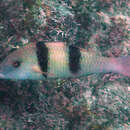Diagnostic Description
provided by Fishbase
Description: Occurs in 3 color forms that might represent different species. The Indian Ocean form has 2 sharply defined wedge-shaped bars become narrower and sometimes end on the belly. The Indo-Australian form has 3 very distinct dark patches and rows of yellow spots on the sides. The Pacific Plate form has 2 wide bars that extend to the belly (Ref. 37816). Head length 2.9-3.3 in SL, length of snout 1.7.-2.1 and barbel 1.5-1.9 in HL; body depth 2.8-3.4 in SL (Ref. 90102).
Morphology
provided by Fishbase
Dorsal spines (total): 8; Dorsal soft rays (total): 9; Analspines: 1; Analsoft rays: 7
Trophic Strategy
provided by Fishbase
This occasionally schooling species inhabits lagoon and seaward reefs: juveniles on reef flats, adults tend to occur around rocky or coralline areas of high vertical relief. Feeds on crustaceans at daytime and on fishes and crab larvae at night. Also feeds on worms (Ref. 6113). Uses its sensory chin barbels to probe the sea floor for hidden prey; preys after dark on such diurnal fishes as blennies and damselfishes, probably taking them from where they shelter themselves at night (Ref. 13550).
Biology
provided by Fishbase
This occasionally schooling species inhabits lagoon and seaward reefs: juveniles on reef flats, adults tend to occur around rocky or coralline areas of high vertical relief. Feeds on crustaceans at daytime and on fishes and crab larvae at night. Also feeds on worms (Ref. 6113). Occurs in 3 color forms. The Indian Ocean form has 2 sharply defined wedge-shaped bars become narrower and sometimes end on the belly. The Indo-Australian form has 3 very distinct dark patches and rows of yellow spots on the sides. The Pacific Plate form has 2 wide bars that extend to the belly (Ref. 37816).
- Recorder
- Estelita Emily Capuli
Importance
provided by Fishbase
fisheries: commercial
- Recorder
- Estelita Emily Capuli

